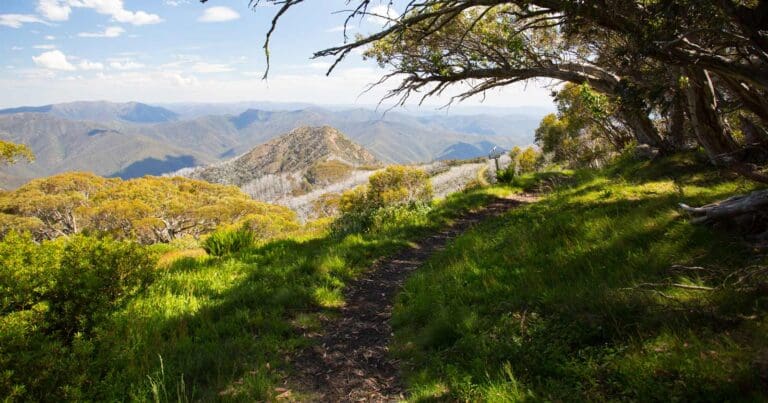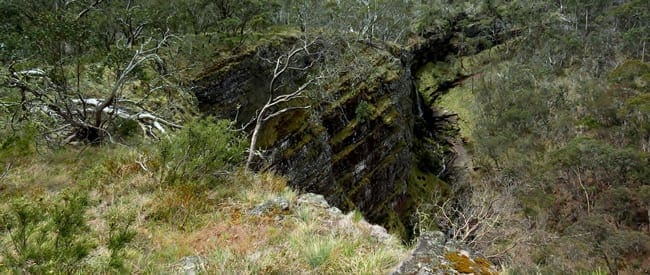Hike at a Glance
Max elevation: 1739m
Min elevation: 1264m
Total Ascent: 558m
Hike overview
Starting near Telephone Box Junction at Mount Stirling, this 13 km, grade 3 hike in Victoria's Alpine National Park forms a large loop around the Mount Stirling resort. Known as the Mount Stirling Summit Loop, the hike typically takes around five hours to complete. Along the way, you’ll pass iconic landmarks like Bluff Spur Memorial Hut, Geelong Grammar School (GGS) Hut, King Spur Hut, and Cricket Pitch Shelter, before returning to Telephone Box Junction.
From the starting point, follow the upper right section of Circuit Road, then turn left onto Baldy Loop and right onto Bluff Spur Trail, leading you up to Bluff Spur Hut. Continue past the hut, keeping South Summit Trail on your right and West Summit Road on your left. When you reach the Howqua Gap track, turn left, following the unsealed road that runs past Stirling Summit.
For those seeking an optional side trip, a short but steep walk leads to the 1,749-meter summit. After enjoying the summit, retrace your steps to the main trail. At the Clear Hills track intersection, turn left through the gate to reach GGS Hut and follow the Stirling Trail. Just before reaching the Cricket Pitch, take a left onto Weather Station Ramble, then continue along Upper Baldy Trail, passing the Machinery Shed.
At the intersection of Upper Baldy Trail and Baldy Loop, continue straight on Upper Baldy Trail. After passing the Practice Slope, turn left at the Circuit Road intersection, which will lead you back to Telephone Box Junction.
Towards the end of the hike, several alternative tracks offer slight variations to the described route. A GPX file for a 12 km variation of this loop is included below for reference.
Please note that this track is subject to seasonal closures. When snow is present, snowshoes must be worn. As a general guide, walking/hiking is encouraged from October to May, and snowshoeing from June to September. For up-to-date information on access, snowshoe etiquette, and trip planning, please contact the Mansfield Visitor Information Centre at 03 5775 7000.
Finding Water
While it's recommended to start the hike with 2-3 litres of water, there are several reliable water sources along the Mount Stirling Summit Loop. Water availability can vary depending on recent weather conditions and the time of year, so carrying a water filter or purification device is strongly advised if you plan to rely on natural water sources. Here are the key water points along the route:
Hut Water Tanks
Each of the following huts has a water tank nearby, but availability may vary depending on conditions:
- Bluff Spur Hut: Has a tank next to the hut.
- GGS Hut: Known for its reliable water tank, which often has water even after dry periods.
- King Spur Hut: A good option for refilling, with a tank adjacent to the hut.
- Cricket Pitch Shelter: Features a tank next to the shelter.
Natural Water Sources
- Fork Creek: A free-flowing creek located about 75% of the way around the loop (anti-clockwise), making it a dependable spot to refill.
- Northern Face of the Summit (Near GGS Hut): A water seep can often be found on the track down to GGS Hut. Look for a small puddle forming along the trail. A water filter is essential for this source.
- Stirling Trail (Between King Spur Hut and GGS Hut): A shallow seep flows out of the ground in this section. Listen for the sound of running water as you approach.
- West of Cricket Pitch Shelter: A seep or small creek feeds a horse trough in this area. Treat the water before use.
- Stirling Trail (Near Signpost 27): A small spring can be found on the right-hand side of the trail heading toward King Spur Hut.
Always treat any natural water source to ensure safety, and be mindful that seasonal closures or dry conditions can affect water availability. For the most up-to-date information, contact the Mansfield Visitor Information Centre at 03 5775 7000 before your trip.
Tips
Mount Stirling offers several locations for overnight bushwalk camping, allowing you to experience the Australian alpine wilderness. To ensure you have a fantastic camping experience and help preserve the alps for others, please follow the tips below:
- Camp among the snow gums rather than in lower Mountain Ash areas, as Mountain Ash trees are prone to falling unpredictably.
- Be prepared for all weather conditions, as alpine weather can change suddenly and without warning.
- Carry a map and compass, and make sure you know how to use them before setting out.
- Inform someone of your plans or complete a trip intention form.
- Use the provided toilets, or dig deep holes at least 100 metres from waterways to protect both animal and human health.
- Be mindful of fire safety and evacuation locations. Do NOT light fires on fire ban days—if in doubt, don’t light it!
- Ensure you haven’t disturbed any precious flora or fauna during your hike.
- Use the rubbish bins provided, or carry out all your litter.
Gallery
Got some great shots from this hike? Upload your photos here to inspire others and show off the beauty of the trail!
Uploading your photos doesn’t mean you lose ownership. You can be credited for your contributions, and you can request removal at any time.
Content use
Please don’t copy GPX files or content from this site to AllTrails or other platforms. Each trail has been personally mapped, documented, and refined to support Australia’s bushwalking and hiking community. While some details come from land managers, every listing reflects significant personal effort. This is a free, community-driven initiative—your respect helps keep it that way.
Walk map and GPX file
Mount Stirling Summit Loop (13km)
Max elevation: 1739 m
Min elevation: 1264 m
Total climbing: 558 m
Total descent: -558 m
Mount Stirling Summit Loop (12km)
Max elevation: 1739 m
Min elevation: 1264 m
Total climbing: 528 m
Total descent: -528 m
Getting there
Getting to the trailhead: Alpine National Park.
From Mansfield, take Mount Buller Road for approximately 30 km until you reach the toll gate at Mirimbah (an entry fee applies during the declared winter season). After passing through the gates, turn left onto Stirling Road and continue for about 8 km along an unsealed road until you reach Telephone Box Junction (TBJ). Public vehicle access beyond TBJ is restricted from the Thursday after the King’s Birthday weekend until the Thursday before Melbourne Cup Day. Gates may close earlier if skiable snow is present. During winter, vehicles are not permitted beyond TBJ, and all 2-wheel drive vehicles must carry chains when traveling to this point.
Closest towns to this walk: Benalla, Bright, Dinner Plain, Falls Creek, Harrietville, Hotham Heights, Mansfield, Mitta Mitta, Mount Beauty, Mount Hotham, Myrtleford, Omeo, Porepunkah, Tawonga South, Wangaratta
About the region
Mount Stirling is the only Victorian alpine resort with a largely undeveloped, unspoilt alpine summit, offering visitors a readily accessible 'semi-wilderness' experience. This, along with its rich environmental diversity and close proximity to Melbourne (230 km), makes Mount Stirling unique in the Australian Alps.
The summit of Mount Stirling, standing at 1,749 metres, provides a 360-degree panoramic view of the surrounding mountain ranges. The breathtaking high country landscape features sub-alpine Alpine Ash forests, Snow Gum woodlands, and wide expanses of alpine meadows, which are stunning in both summer and winter.
The Alpine National Park is a vast, 646,000-hectare park located in Victoria's Central Highlands and Alpine regions, northeast of Melbourne. It is the largest national park in Victoria, covering much of the higher areas of the Great Dividing Range, including Mount Bogong—Victoria's highest peak at 1,986 metres—and the subalpine woodland and grassland of the Bogong High Plains. The park's northeastern boundary borders New South Wales, where it meets Kosciuszko National Park.
For more information, visit the Mount Stirling website.
Similar walks nearby
Looking for more walks in or near Alpine National Park? Try these trails with a similar difficulty grade.
Track grade
Grade 3 (Moderate) - Walks for Most Fitness Levels: Grade 3 on the AWTGS represents moderate walking tracks. These are ideal for walkers with some fitness who are comfortable with some hills and uneven terrain. While suitable for most ages, some bushwalking experience is recommended to ensure a safe and enjoyable experience. Tracks may have short, steep hill sections, a rough surface, and many steps. The total distance of a Grade 3 walk can be up to 20 kilometers.
Explore safe
Plan ahead and hike safely! Carry enough water, pack layers for changing conditions, and bring safety gear like a torch, PLB, and reliable communication device. Check official sources for trail updates, closures, and access requirements, and review local weather and bushfire advice. Most importantly, share your plans with someone before you go. Being prepared makes for a safer and more enjoyable hike! Stay Safe, Explore More, and Always #ExploreSafe.
Packing checklists
What you carry in your pack depends on factors like weather, terrain, and your adventure type. Not sure what to bring? My free planning, food, and packing checklists are a great starting point, covering day hikes, overnight trips, and multi-day adventures. Use them to customise your kit and always prioritise safety.
Let someone know
Before heading out, take a moment to fill out your trip intentions form. It’s a quick way to share your hike details with family or friends. If something goes wrong, they can notify emergency services, ensuring a faster response and peace of mind. Stay safe and enjoy your adventure
Suggest an edit
Spotted a change on this trail? Maybe there are new features, the route has shifted, or the trail is permanently closed. Whatever the update, I’d love your input. Your feedback helps fellow hikers stay informed and ensures that our trail info stays fresh and reliable.
Acknowledgement of Country
Trail Hiking Australia acknowledges the Traditional Owners of the lands on which we hike and pay respects to their Elders, past and present, and we acknowledge the First Nations people of other communities who may be here today.






